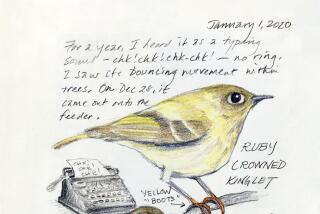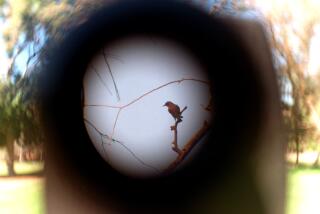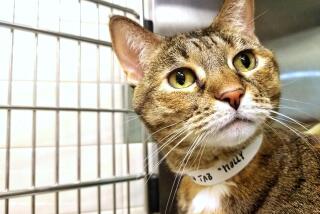A Clean Feeder Helps to Keep Birds Healthy
- Share via
Question: For my birthday, my husband bought me a bird feeder, which he set up in our garden. Now that there are fewer birds around, I’m wondering if I should bother to scrub out the feeder. My husband thinks bleach would hurt the birds that show up in the spring.
--Y.G., Santa Monica
Answer: Your instincts are right. According to the U.S. Geological Survey’s National Wildlife Health Center, unclean bird feeders can contribute to the spread of bacterial, viral and even fungal diseases in birds that eat at backyard feeders.
If it’s hard to believe what you can’t see, just imagine eating at a restaurant where the plates are never washed, the waiter slopping your food on top of the previous patron’s dirty plate.
In the case of several diseases, like trichomoniasis and avian pox, the birds can develop lesions in their mouths and throats or on the featherless surfaces of their faces, legs and feet.
But rather than dying from the disease outright, the birds often die from starvation because they can’t get food or can’t swallow what they do manage to get.
You can keep your feeder clean by using good-quality, clean feed. Store it in a closed, rodent-proof container in a dry location, and don’t store it for long periods of time.
Clean up the area underneath the feeder frequently. (You should really have an elevated catch basin under the feeder anyway, to keep squirrels from overtaking your yard.)
To disinfect the feeder, soak it for three minutes in a mixture of nine parts water and one part bleach. Rinse well and allow it to dry completely before hanging it back up.
At my house, we clean the feeders about once a month, although a good dousing every two weeks is probably better. Replace old, cracked feeders; they’re tough to keep clean.
If you’re having great success with your feeder, consider hanging second and third ones in other parts of your yard to prevent overcrowding.
Use different seed in each feeder, and you’ll soon learn which species in your yard favor which feed.
*
Q: I have a problem with my neighbor’s nine cats messing all over my yard. They use the lawn and flower beds as a latrine, entering the yard by going over and under the fence. I’ve talked to my neighbor about it, and he does nothing. My yard is smelly and my patience is wearing thin. Can you help me remedy this situation?
--J.M., Los Angeles
A: This is more a people problem than a feline one.
I talked with a wildlife specialist at the UC Davis Agricultural Extension Station and wildlife biologist Ron Jurek at the California Department of Fish and Game. The consensus was that there are two approaches, the soft and the hard.
The soft approach, which you’ve tried, begins with diplomacy. You’re muddying the waters if you don’t take the first step and talk with the neighbors, Jurek said. Show them what the cats are doing. Provide possible solutions, like suggesting the animals stay in the house rather than roaming around.
According to Jurek, allowing cats to roam outdoors presents a conflict between personal liability and responsibility. Not to mention the fact that domestic cats kill millions of birds and small mammals each year.
The soft approach also involves trying to outwit the cats. All the rage among urban wildlife professionals is a newfangled motion-activated sprinkler that directs a quick, powerful spray of water at whatever moves into the sensor’s field of vision.
You may want to buy a couple and set them to spray the cats where they enter your yard to give them an unwelcome but harmless surprise.
To keep cats from using your flower beds as a latrine, lay wire mesh over the top of the beds, up and around the base of the plants. For some reason, cats seem to dislike walking over it. This won’t prevent them from spraying, though.
You can also fill a mesh bag with mothballs and lay it across the fence line or around the flowers. The bag allows you to easily remove the moth balls later, which you can’t do with flakes. If there are toddlers or children in the area, forget this tactic.
Another strategy is to create a diversionary area in your yard in the hopes it will keep the cats away from your lawns, flowers and doors.
Entice them to this area by planting the catnip plant, which most cats go wild for. Remember that more than one technique used at a time will reinforce the lesson.
Then there’s the hard approach. This is when neighbors draw battle lines and take prisoners--the cats.
To do this, you’ll need to borrow or rent a trap from your local humane organization. Be sure the group will allow you to deliver the cats to it once they’ve been trapped, and that the group will call the owner to have them picked up.
Trap humanely. Leave food and water in the cages, keep them out of the hot sun, check the traps several times a day and deliver any trapped cats immediately to the shelter, along with your neighbor’s phone number.
The hard approach is an uncharitable solution at best and should be the last step you take, not the first.
It ensures that you will live in a permanent state of battle with your neighbors, akin to the Hatfields and McCoys. Maybe readers have some other ideas about how to handle this problem.
Living With Wildlife is published every other Thursday.
Send your queries to wildlife biologist Andrea Kitay at P.O. Box 2489, Camarillo, CA 93011, or via e-mail to [email protected]. Please include your name and city. Questions cannot be answered individually.
For a list of Wildlife Bulletins that provide sound advice on homeowner-wildlife conflicts ($4 each), send a stamped, self-addressed envelope to the above address, or visit https://www.livingwithwildlife.com.






